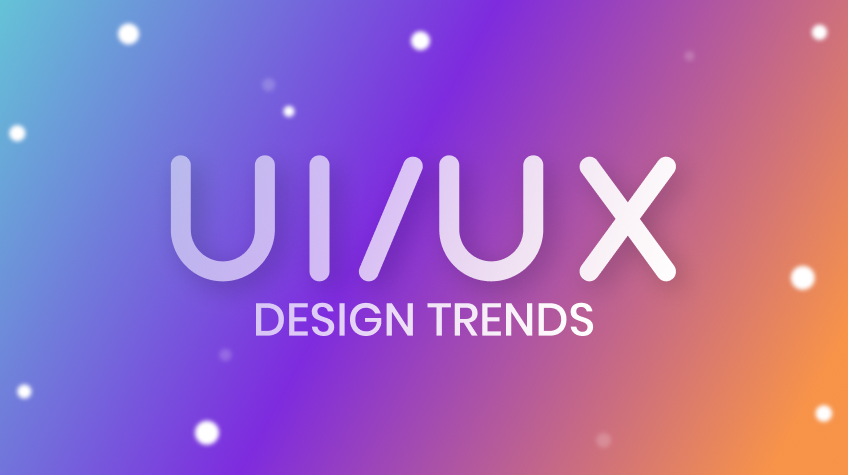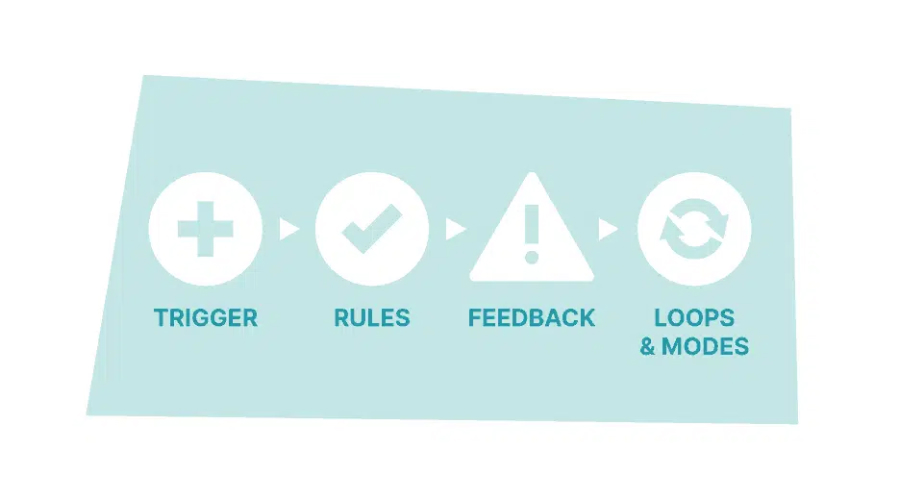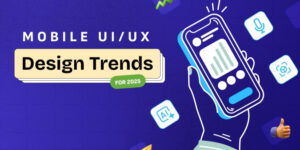
As digital experiences continue to evolve, UI UX design stands at the forefront of innovation. As we progress through 2025, the intersection of creativity and functionality takes center stage, shaping how users interact with technology. “Top 10 UI UX Design Trends in 2025” unveils a captivating journey through the latest design evolutions.
From the tactile allure of Neumorphism 2.0 to the immersive depths of 3D design, this exploration promises to unravel the dynamic tapestry of trends propelling user interfaces and experiences into the next frontier. Join us as we dissect the visual language of tomorrow, where every click, swipe, and interaction tells a story of innovation and user-centric design.
Why should we stay ahead in UI UX Trends?
Staying ahead in UI UX trends is paramount in the digital era, ensuring perpetual relevance and user satisfaction. Users’ expectations in the digital landscape evolve swiftly. By anticipating and adopting emerging trends, designers can craft interfaces that resonate with contemporary preferences, enhancing user engagement and loyalty.
Proactively embracing innovation also positions businesses as industry leaders, fostering a competitive edge. Furthermore, staying ahead in UI/UX trends is an investment in user-centricity, demonstrating a commitment to delivering seamless, enjoyable experiences in a world where first impressions matter; staying abreast of design trends is the key to creating interfaces that captivate and resonate with users.
What are the advantages of UI UX designs?
UI UX design offers a myriad of advantages in the digital realm. Primarily, it enhances user satisfaction by creating intuitive, visually appealing interfaces that streamline interaction. Effective UI UX design increases user engagement, fostering brand loyalty and positive experiences.
It also reduces bounce rates and enhances conversion rates as users navigate seamlessly through well-designed interfaces. Beyond user-centric benefits, strategic UI UX design boosts brand credibility, aligning aesthetics with functionality. By focusing on accessibility and inclusivity, it ensures a broader reach, accommodating diverse user needs. Ultimately, investing in UI UX design invests in digital products and services’ success, reputation, and longevity.
10 Best UI UX Design Trends
Here are the Top 10 UI UX Design Trends in 2025
1. Neumorphism 2.0

Neumorphism has evolved significantly from its inception in 2022 to a refined Neumorphism 2.0 in 2025. Designers embrace subtler nuances, shifting from stark contrasts to softer shadows and gradients. This evolution introduces a more tactile feel, resembling real-world elements.
In this iteration, Neumorphism strikes a delicate balance between depth and minimalism, creating interfaces with a more organic and visually engaging appeal. Designers leverage these subtler shadows and gradients to craft buttons, cards, and elements that mimic physical interactions, enhancing user experience by inviting touch and interaction while maintaining a clean, modern aesthetic.
2. Immersive 3D Design
The ascent of immersive 3D design marks a transformative chapter in UI UX, captivating users with dynamic and visually striking elements. In 2025, the popularity of 3D elements has surged, seamlessly blending aesthetics with functionality. Websites and applications now leverage 3D design to transcend flat interfaces, creating engaging user experiences that transcend traditional limitations.
Notable examples include gaming platforms using 3D to enhance realism, e-commerce sites offering interactive product views, and educational apps employing 3D models for enhanced learning. The rise of immersive 3D design heralds a new era where digital experiences transcend boundaries and captivate users in unprecedented ways.
3. Microinteractions with Purpose

Microinteractions, often overlooked, play a pivotal role in elevating user engagement. In 2025, designers recognize their significance, understanding that these subtle details contribute profoundly to the overall user experience. Purposeful micro-interactions, such as animated feedback upon a successful action or a subtle vibration confirming a tap, provide instant user gratification and establish a seamless and intuitive connection between the user and the interface.
Examples abound, from social media ‘like’ animations to progress indicators, where each micro-interaction serves a specific purpose, transforming user interactions into a delightful, responsive dance that enhances the overall digital journey.
4. Voice User Interface (VUI) Advancements
Voice User Interface (VUI) is undergoing a sophisticated evolution in 2025, surpassing conventional expectations. Integrating advanced natural language processing and machine learning has elevated VUI, enabling more nuanced and context-aware interactions. Innovative voice interactions are now seamlessly woven into various digital products, showcasing the technology’s prowess. Examples include:
- Virtual assistants understand complex queries.
- Hands-free control in smart homes.
- Voice-activated commands in navigation apps.
This evolution in VUI enhances user convenience and marks a shift towards more intuitive and personalized digital experiences, where users can effortlessly communicate with technology in a manner that mirrors natural conversation.
5. Dark Mode Evolution

Dark mode design has undergone a compelling evolution in 2025, transcending its initial aesthetic appeal. Beyond the conventional white-on-black palette, designers are exploring creative implementations, prioritizing user experience. Intuitive adjustments to contrast ratios, ambient light sensing, and adaptive color schemes are redefining dark mode’s visual impact.
Examples range from social media platforms offering customizable dark themes to productivity apps employing subtle gradients for legibility. This evolution caters to users’ aesthetic preferences and acknowledges the importance of accessibility, reducing eye strain, and enhancing readability. Dark mode has evolved into a nuanced design choice, contributing significantly to an enriched and comfortable user experience.
6. Sustainability-driven Design
In 2025, sustainability-driven design takes center stage, reflecting a heightened awareness of digital products’ environmental impact. Designers increasingly integrate eco-friendly elements into UI UX solutions, emphasizing minimalist aesthetics and energy-efficient features.
Examples include interfaces with low-energy consumption modes, sustainable color palettes, and digital platforms promoting eco-conscious behaviors. From reduced carbon footprints to mindful resource usage, sustainability-driven design aligns with global environmental goals and resonates with users seeking responsible and eco-friendly digital experiences. This evolution signifies a crucial shift toward more conscientious design practices, fostering a harmonious relationship between technology and environmental stewardship.
7. Inclusive Design
In 2025, there’s a notable shift towards inclusive and accessible design, recognizing the diverse needs of users. Designers prioritize features like customizable font sizes, color contrasts, and alternative navigation methods. Interfaces now accommodate users with varying abilities, ensuring a seamless experience.
There are screen readers for people who are blind, voice commands for hands-free navigation, and text-to-speech functionalities. This paradigm shift fosters a more empathetic digital landscape and broadens the reach of products, making them universally accessible. Inclusive design is not just a goal but an essential ethos, creating digital experiences that empower every user.
8. Augmented Reality (AR) Integration
In 2025, Augmented Reality (AR) is seamlessly weaving into UI/UX design, transforming user interactions into immersive experiences. Designers are harnessing AR to blend the digital and physical realms, offering users a dynamic and interactive interface. Examples abound, from retail apps allowing users to virtually try on products to navigation apps overlaying real-time directions on the physical world.
This integration enhances engagement by providing contextual information and real-world interactions, offering a glimpse into the future where digital elements harmoniously coexist with the user’s environment. AR is becoming a cornerstone in elevating UI/UX, pushing the boundaries of creativity and functionality.
Detailed Article: The Potential of Augmented Reality (AR) in UI/UX Design
9. AI-Powered Personalization
In 2025, AI is revolutionizing user experiences through personalized design, adapting interfaces to individual preferences with unprecedented precision. Machine learning algorithms dynamically analyze user behavior, preferences, and historical data to tailor interfaces.
Examples include content recommendation engines in streaming services, personalized shopping experiences, and adaptive news feeds. AI’s ability to learn and predict user preferences enhances engagement, streamlines navigation, and fosters a sense of individualized interaction. This era of AI-powered personalization transcends one-size-fits-all approaches, ushering in a new age where digital interfaces intuitively respond to each user’s unique needs and tastes, elevating the overall user experience.
10. Data Visualization Mastery
Effective data visualization is paramount in UI/UX, translating complex information into digestible insights. In 2025, designers masterfully wield data to enhance user comprehension through innovative visualization techniques. Dynamic charts, interactive graphs, and immersive infographics reshape how users interact with intricate datasets.
Examples include real-time analytics dashboards with intuitive color-coded metrics, spatial data representations for enhanced geographical understanding, and animated charts that simplify temporal trends. By transforming raw data into visually compelling narratives, designers empower users to glean meaningful insights effortlessly, fostering a deeper understanding and engagement within the digital interface. Data visualization mastery is a cornerstone in creating interfaces that inform and captivate.
Also Read: Roles and Responsibilities of UX Designers in the Era of AI
Conclusion
We have reached the end of our discussion of the “Top 10 UI UX Design Trends in 2025,” the digital world is undergoing a transformative journey. From the tactile elegance of Neumorphism 2.0 to the immersive realms of 3D design, each trend unveils a narrative of innovation.
The significance of microinteractions, sustainability-driven and inclusive design reflects a commitment to user-centricity. Evolutions in VUI, dark mode aesthetics, AR integration, AI-powered personalization, and data visualization mastery underscore the dynamic synergy between technology and human experience. As designers navigate these trends, they propel us toward a future where interfaces seamlessly blend creativity, functionality, and a profound understanding of user needs.






